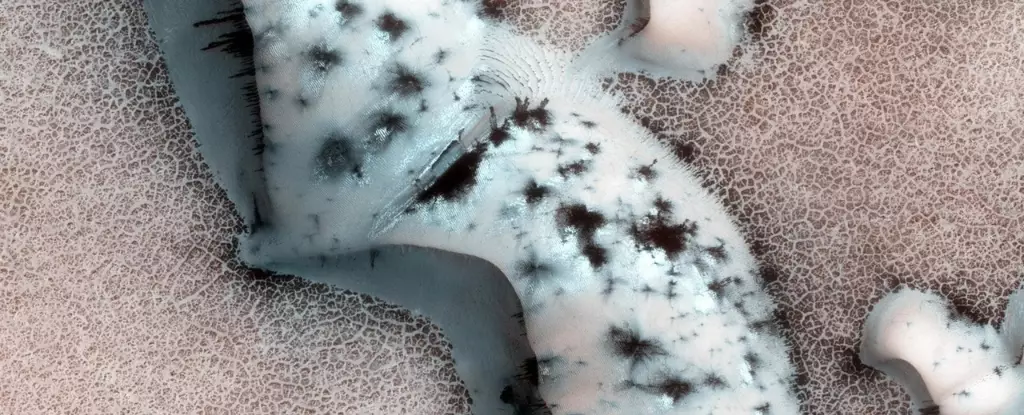Mars, often dubbed the “Red Planet,” is a stark and desolate landscape distinct from any environment found on Earth. Its surface, adorned with iron oxide, evokes a sense of wonder and curiosity among scientists and enthusiasts alike. While many celebrate Earth’s lush ecosystems and vibrant biosphere, Mars offers a different allure—one steeped in geological phenomena that have emerged in an alien atmosphere. The Martian environment is characterized by a thin atmosphere composed predominantly of carbon dioxide, which shapes the planet’s unique seasonal features.
During the long Martian winter, temperatures plummet, resulting in the freezing of carbon dioxide, which then blankets the polar regions in a thick layer of frost. As the seasons shift toward spring, the ice begins to interact dynamically with sunlight. The translucent CO2 layer allows sunlight to penetrate, warming the ground beneath, creating a situation reminiscent of greenhouse effects observed on Earth. This process is critical for understanding the cycle of CO2 on Mars, forming the stage for one of the planet’s most striking phenomena: the geysers.
As temperatures rise, the frozen CO2 sublimates, transitioning from a solid state directly into gas. This process occurs at the surface of the ice, where pressure builds up beneath the layer. Eventually, the pressure becomes sufficient to cause the solid CO2 to rupture, leading to spectacular eruptions that thrust gas and particulate matter into the Martian atmosphere.
The geysers observed on Mars are not merely whimsical geological features; they represent a powerful natural process. NASA’s Mars Reconnaissance Orbiter, equipped with the high-resolution HiRISE camera, has provided a closer look into these remarkable eruptions. The geysers can eject gas at astonishing speeds of up to 160 km/h, with dark material spreading across the icy surface—often creating spots up to 1 kilometer in diameter.
These eruptions serve as an excellent reminder of how active Mars is, despite its barren and ominous exterior. The presence of CO2 geysers signifies that the planet’s surface is subject to processes we do not encounter on Earth. These eruptions form patterns that resemble intricate spider webs, leading scientists to designate this terrain as “araneiform” or “spider terrain.” Seen from above, these formations contribute to Mars’ eerie beauty and underline its geological complexity.
The mechanics behind these fascinating phenomena have intrigued researchers for years. The Keiffer model offers valuable insights into the formation of the spider-like patterns. This model suggests that the seasonal ice cap, with its impermeable CO2 layer, traps gas that builds up beneath the surface, leading to eruptions. As scientists replicate these processes in lab settings, a clearer understanding of how gas pressure and thawing ice coexist and catalyze these eruptions emerges.
The comparison between Mars and Earth offers a compelling narrative. While Earth is celebrated for its biodiversity and life forms, Mars unveils a landscape where life, as we know it, does not exist—yet it showcases astonishing geological features born from the very elements that dominate its atmosphere. The findings from Mars have led to the conclusion that while the processes are similar in principle, they are markedly different in application and consequence, highlighting the distinctiveness of Mars.
Ultimately, the uniqueness of Mars and its geological phenomena stirs a blend of scientific inquiry and philosophical reflection. The beauty of Earth has long inspired poets, artists, and dreamers, but the remnants of ancient Martian activity—the CO2 geysers and the mesmerizing araneiform terrain—whisper a different story. They invite us to rethink our understanding of beauty and nature itself. These observations serve as a reminder of the diverse realities that exist within our solar system.
In the grand narrative of our universe, Mars stands as a testament to the beauty of nature’s diversity. The planet’s geological features remind humanity that while we may cling to our terrestrial roots, the cosmos offers landscapes and processes that challenge our perceptions and ignite our imagination. The explorations of Mars are not just about revealing the planet’s history, but also about enriching our understanding of the universe and our place within it.


Leave a Reply